Toshiba Chromebook 2: A Feast for the Eyes
by Jarred Walton on February 11, 2015 10:00 AM ESTToshiba Chromebook 2: A Beautiful Display
We’ve talked quite a bit already about the great display in the Toshiba Chromebook 2. Really, it’s the primary reason to buy this laptop over one of the alternatives, and as such it’s the best place to start our objective benchmarks. For these tests, we can’t create a color profile so what you get in the box is what you’re going to have to live with, meaning display quality becomes even a bit more important. On the other hand, it’s also important to remember that having really accurate colors is mostly a concern for imaging/video professionals or A/V enthusiasts, and you could certainly argue that neither group is really looking to use a Chromebook. For most users, the most compelling aspect is going to be the LCD viewing angles, as it means you don’t have to be positioned perfectly to get a legible screen:
TN panels always have problems with vertical viewing angles, which makes them a particularly bad choice on laptops as you’re frequently looking at the screen from slightly above rather than straight on. Over the years, at least that aspect has improved slightly, but it’s still clearly inferior to the experience that an IPS panel can offer – and don’t even get me started on the “from below” angles on TN, though that’s usually less of a concern. The Toshiba Chromebook 2 1080p display has no problems, regardless of viewing angle, and you reach the point where the angle is far too oblique to be useful before you have any issues with color shifting. Let’s move on to the color accuracy figures.
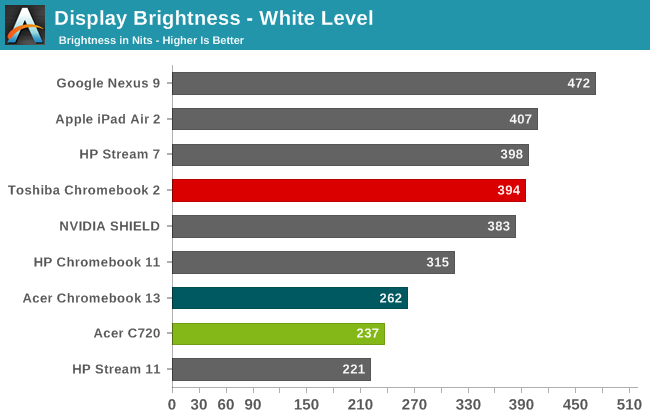
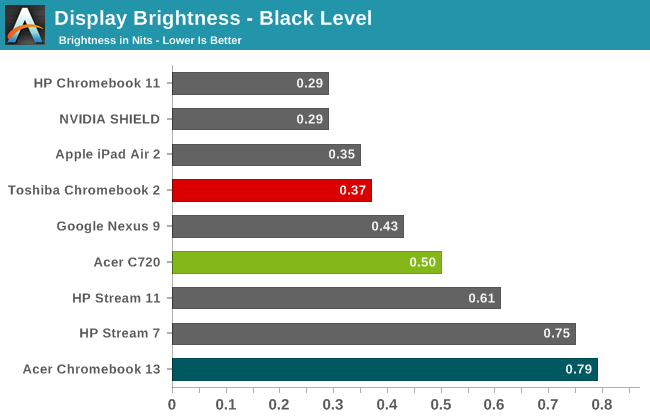
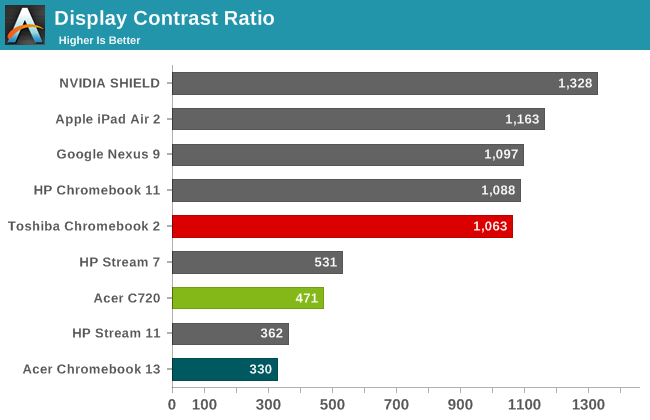
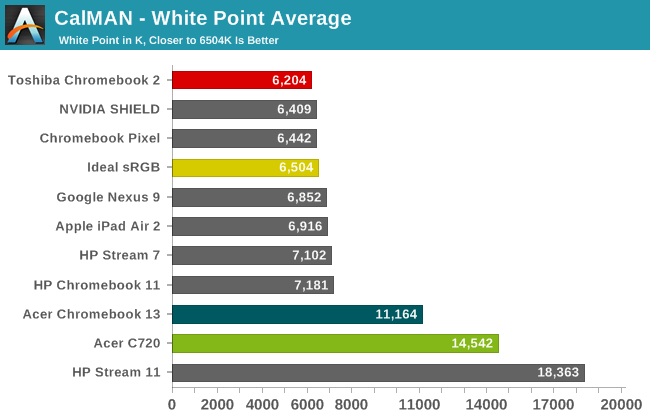
The maximum brightness of nearly 400 nits is great to see, as it makes this laptop useable even in outdoor environments, though reflections from the glossy display can still be a problem. The black levels at maximum brightness are 0.371 as well, which while not perfectly black are still closer than what you’ll see on most other laptops. Combined, we end up with a contrast ratio of 1063:1, though I should note that contrast improved at 200 nits to 1291:1 thanks to a proportionally better black level. The white point is also quite good, coming closer to the desired 6504K than any other Chromebook we’ve tested so far.
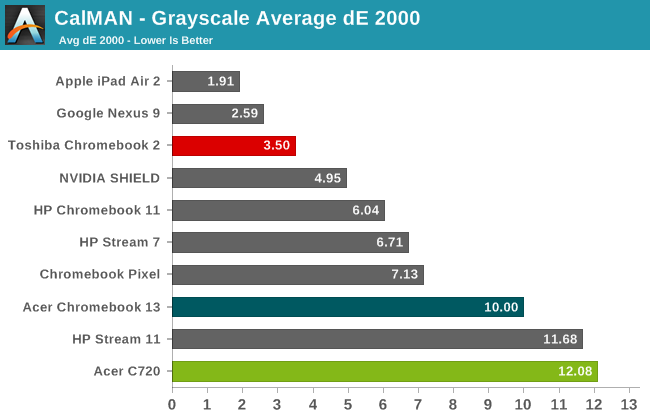

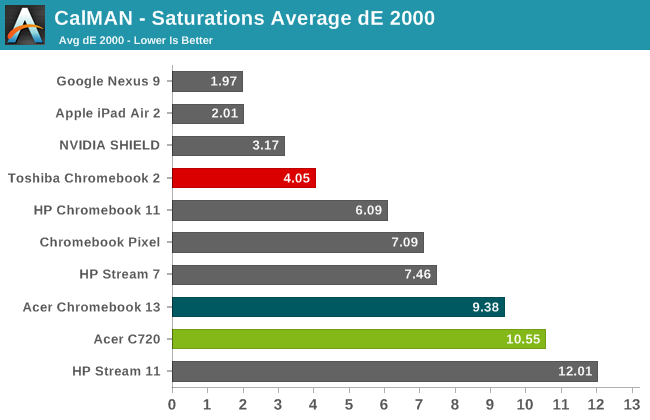
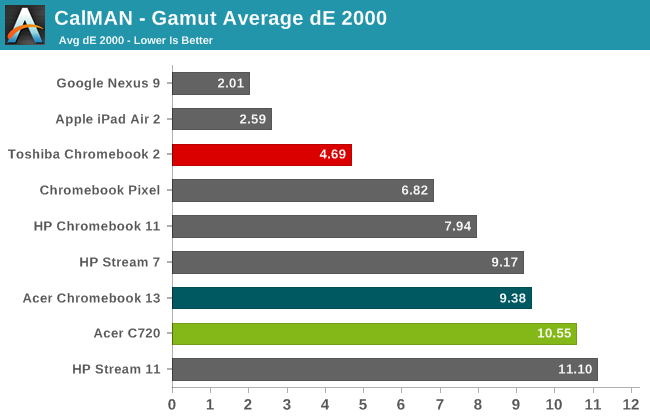
Delta E values could still be improved, but it has to be said that the Toshiba display still rates far better than the vast majority of Windows laptops we’ve tested. There are definitely colors that miss the mark, but in most of our tests the average Delta E ends up being around 4.0, which is higher than the desired average of 3.0 but quite a bit lower than the point where inaccuracies start to become distracting (6.0). The only displays we’ve tested in the above charts that do better overall are on the Nexus 9 and iPad Air tablets, and those are the two best tablet displays we’ve tested. When you look at the results of the other Chromebooks (including the Pixel), Toshiba really stands out from the crowd of mediocre color quality.
If you want more details on the display, the above gallery contains additional charts for our LCD quality testing. Color gamut is basically equal to sRGB, which is what most people would want on an Internet-centric device. Basically, it's a really good display, and exceptional to find such quality on a $300 laptop. I just wish we could get any Windows laptop for under $750 with something close to this level of quality. For all of those who comment that they “stopped reading after seeing how bad the display was”, at least this time there’s nothing to complain about. I still wish this sort of performance was more of the norm rather than the exception, and perhaps we’ll get there over the coming years, but regardless it’s a nice change of pace – and all the more refreshing to see on a $329 device.





















66 Comments
View All Comments
RadioShackLives - Wednesday, February 18, 2015 - link
I really enjoyed this review.I bought the Toshiba CB35-A3120 13.3-Inch Chromebook last year for my girlfriend. I am a graduate student studying computer science and have experience with OSX, Windows, Linux, and Chrome OS. With the chromebook I don't have to spend an hour every month removing viruses from the PC the way I did with her Windows laptop. If anyone has to deal with supporting Windows for friends and family Chrome OS is a great alternative.
I also installed Ubuntu on my girlfriend's chromebook. I downloaded Sublime Text and Libre Office. I also downloaded Ruby and was able to run some Ruby programs I created without any issue. Keep in mind the Chromebook I used had the Celeron 2955U processor. I'm curious if Bay Trail would be much different.
The only downside is to get crouton you ha be to leave the chromebook in developer mode so it won't boot up as quickly. However I like the combination of linux + chrome OS. Linux lets me work on coding assignments but when I want to watch HBOGO I can switch over to chrome OS.
Lastly, don't be one of these jokers that complains about not being able to run Photoshop. You remind me of the people that buy ultrabooks on Amazon and complain that there is no DVD drive.
tipoo - Tuesday, March 1, 2016 - link
Jeeze, what was she doing to get a virus a month?sirkiwi - Thursday, March 5, 2015 - link
I am pleasantly surprised that such an inexpensive product can come with such a high quality 13.3" 1080p screen. Now, if only we could get that on a Windows notebook. The fact that we can't is just outright infuriating.calexander16 - Tuesday, April 14, 2015 - link
Beware of the Toshiba Chromebook 2 - there appears to be a quality issue with its display.After four months of normal laptop use, a crack developed in the membrane (?) behind the display glass. I sent pictures to Toshiba for the warranty claim - and they rejected it, claiming "physical damage" was done to the machine.
If opening and closing the lid normally is considered physical damage, I guess they're right.
Wondering if I was the lone crank in the Toshiba electronics universe, I went onto Amazon - and lo and behold, under the 1-star reviews there are several reports of display cracks and problems for the Toshiba Chromebook Two within the first few months of ownership. In all of the cases, Toshiba refused to honor its warranty service for these problems.
So be very careful. I suspect a Quality Control issue - and tried to uplevel my concern to Toshiba but met a dead-end in the customer service department.
mbhatia - Saturday, October 17, 2015 - link
Can someone please assist me advising how I can lock an OFFLINE folder/file etc in a Chromebook...on an attached SD card etc. One needs to remain stuck in there because of the low internal memory and I while the Cloud portion of the chromebook is secure, anyone can take out the SD card and access the contents of an unsecured folder. There are apps for this Android and Windows and making a secure drive etc in Mac... how do I achieve something so basic in a Chromebook? This is the only piece of the puzzle missing for me in adopting this full time and loading it up with my data.George.Madison - Thursday, November 26, 2015 - link
You know, I'm a very demanding customer. One day a came to a conclusion that billion corporations around the globe produce their stuff in order to: 1 - sell their products; 2 - truly help people and make their lives easier. First aim is much more valuable than second!That's the reason I always demand products appropriate to thier prices.
Toshiba laptop costs nearly $270 http://cent.im/popular/259/toshiba_chromebook_2
For this amount you receive 13,3'' Full HD screen (which I consider the best decision), fast SSD inside, 4 Gb RAM and 64-bit Windows.
Keyboard is quite convenient. As for mouse, I use my old Logitech.